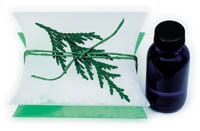Natural gift ideas
This article was originally published in December 2002
(December 2002)
Aromatherapy gifts to make

The power of scent can’t be denied. Here are a few recipes for salts, oils, and sprays to create a custom bath basket for you or a friend. Essential oils and basic ingredients are available at all PCC stores.
Salts
These are great to give to co-workers and friends. Wrap in a canister or cellophane bag and tie with a sprig of pine.
- Desktop Salts, a revitalizing salt to smell when you need an aromatherapy pick-me-up: 1 tablespoon coarse sea salt; 10 drops each rosemary and grapefruit oil; and a pinch of dried orange or lemon peel for color.
- Bath salts are a great way to relax after a stressful day. Submerging in salt water eases tired muscles, while essential oils revitalize the spirit:
2 cups Epsom salts or coarse sea salt; 1/2 cup baking soda; several drops essential oils (try lavender for relaxation, lemon for energizing and uplifting, or rosemary for stimulating circulation.) Mix salt, baking soda, and your choice of oils in a small jar. Shake to fully coat the salt and baking soda with essential oils.
Room sprays
Spritz a bit when you need a quick pick-me-up.
- Winter Room Refreshing Spray: 2 drops each lemon, bergamot orange and frankincense; 4 drops lavender; 2 ounces distilled water.
- Citrusy-Sweet Spray: 2 drops each lemon, sweet orange, Clary sage; 4 drops lavender; 2 ounces distilled water.
- Relaxation Spray: 4 drops Clary sage; 2 drops each sandalwood and patchouli; 2 ounces distilled water.
Scented oils
Oil blends to add to your bath, or diffuse in a candle.
- Winter Solstice Blend: 15 drops each lemon and juniper berry; 30 drops each frankincense and myrrh.
- Relaxation/Calming Blend: 6 drops lavender oil; 3 drops geranium.
- Mental Clarity Blend: 6 drops rosemary; 4 drops lemon.
- Prosperity Blend: 6 drops fir needle oil; 3 drops lemon or lemongrass oil.
For the body
Your body deserves to be pampered for the hard work it does. Try some of these body oils during massage or after a shower. For carrier oils, choose sweet almond, jojoba or your favorite vegetable oil.
- Tender Touch Massage Oil: 4 drops frankincense; 6 drops lemon; 7 drops sandalwood; 1/2 cup carrier oil.
- Meditation Body Oil: 5 drops fir needle; 3 drops patchouli; 4 drops sandalwood; 1 ounce carrier oil.ll
- Muscle Relief Oil: 4 drops eucalyptus; 5 drops lavender; 3 drops rosemary; 1 ounce carrier oil.
Moral fiber

by Trudy Bialic, Editor
When you’re shopping for t-shirts, linens or other textiles during the holidays (or anytime), think organic!
After all, organic standards aren’t just for food. Organic fibers also fall under the jurisdiction of the new national organic standards.
Most consumers aren’t aware that growing conventional cotton uses more pesticides than any other crop in the world, except maybe corn. In many developing countries, more than half the pesticides used are applied to cotton.
“Cotton is grown on less then three percent of U.S. agricultural lands, yet it uses 20 to 25 percent of the pesticides,” says LaRhea Pepper, market developer for the Texas Organic Cotton Co-operative and president of Organic Essentials, an organic cotton company. “We’re talking about a chemically intensive crop.”
After harvest, the cotton industry uses more chemicals when the fiber is woven, colored, and finished. It’s sprayed, dipped, and dyed with toxic chemicals at every stage of production. In contrast, no chemicals are applied to organically grown cotton when it’s processed into fabric or the garment for finishing. Specific rules for processing organic fiber, however, still are under development.
By highlighting chemical use and taking sustainability beyond food production, a growing number of forces have begun the uphill climb toward mainstreaming organic fibers. The Organic Consumers Association and Greenpeace have campaigns dedicated to “moral fibers” and “toxic cotton.” The success of organics in food has helped clothing manufacturers, such as Patagonia and Nike, to support a shift toward organic fiber.
Sandra Marquardt, coordinator of the Organic Trade Association’s Fiber Council, says Nike is one of the two largest consumers of organically grown U.S. cotton. Nike now blends more than five percent organic cotton into all it’s U.S. cotton clothes. Nike also just started a new 100 percent organic cotton line this fall. Marquardt says, “Nike is looking at the sustainability of its company and has been really fantastic as a leader in the organic sector, helping to encourage other manufacturers.”
Organic cotton accounts for less than half a percent of global production today, but as Natural Food Merchandiser notes, “the dedicated remain optimistic.” Bena Burda, owner of Maggie’s Organics/Clean Clothes, Inc. says, “If we, as a small percentage, can start affecting changes, then one day those changes will affect the entire industry.” As with organics in food production, we’ve already seen that the dedication of a small minority makes a big difference and can change the way a whole nation views the impact of its product choices.
The PCC Farmland Fund offers t-shirts in two sizes made from 100 percent organic cotton. Buy organic, save the land.
Find sustainable fiber products at www.theorganicreport.org, click on “Home & Garden,” then “Organic Fiber Products.”
